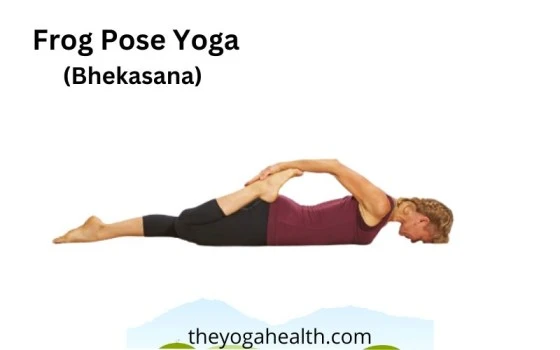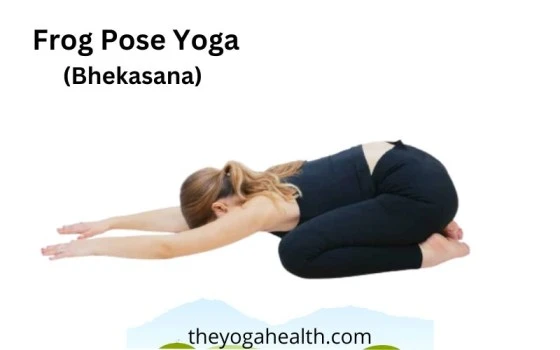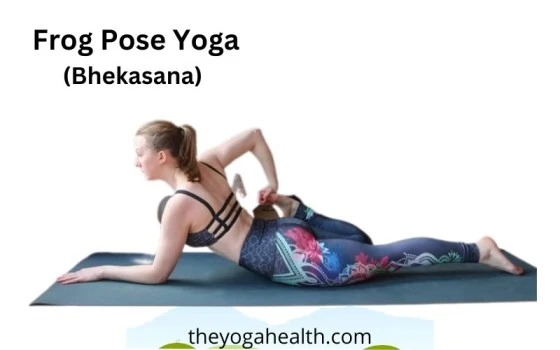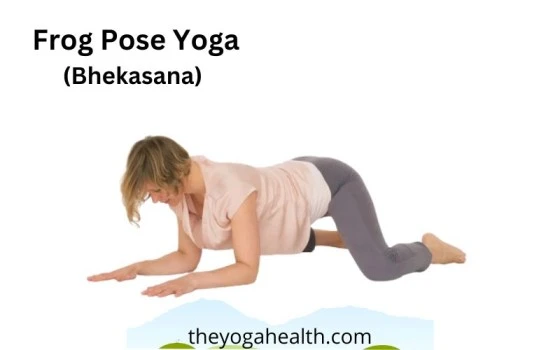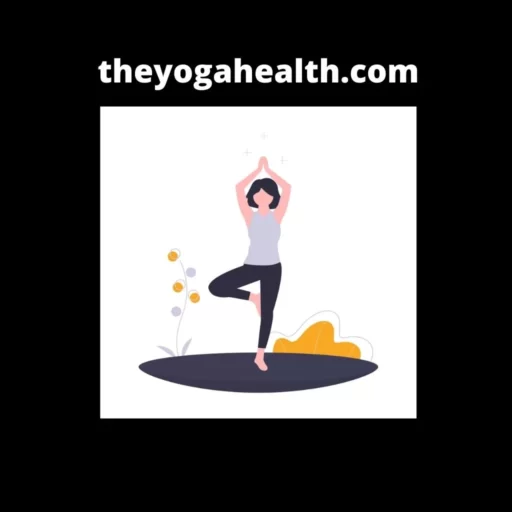Frog pose is a simple yet very effective asana that mainly targets the hips and groin areas. In this article we will explore Frog Pose Yoga Benefits, step-by-step instructions to practice, precautions, and other important points.
This Pose is an excellent addition to your yoga routine for increased flexibility and strength in the lower body.
Table of Contents
Frog Pose Yoga Benefits and meaning
Frog Pose, also known as Mandukasana or Bhekasana, is a yoga posture that imitates the crouched position of a frog. The pose involves spreading the legs wide apart and aligning the knees with the ankles, similar to a frog’s stance. It is a deep hip opener and a powerful stretch for the inner thighs and groin muscles.
Basic Details:
| Sanskrit Name | Bhekasana |
| English Name | Frog Pose |
| Difficulty Level | Beginner |
| Position | Prone |
How to do Frog Pose?
Step 1: Start in a table top position on your hands and knees.
Step 2: Gradually move your knees wider apart, keeping them in line with your ankles. Your feet should be pointing outwards.
Step 3: Press your hips back and downwards and feel the stretch in your inner thighs and groin.
Step 4: You can keep your arms extended in front of you or can also come down onto your forearms for a deeper stretch.
Step 5: Hold the pose for 30 seconds to 1 minute, maintaining a deep, relaxed and steady breath.
Preparing for Frog Pose Yoga
Warm Up
Before attempting the Pose, it’s essential to warm up the body to avoid injury. Gentle hip-opening poses like Bound Angle Pose (Baddha Konasana) and Low Lunge (Anjaneyasana) can help prepare the hips for the intensity of the Pose.
Breath Awareness
During the practice of the Pose, maintain a steady and smooth breath. Avoid holding your breath or straining. Deep and relaxed breathing can help you stay calm and centered, allowing you to explore the pose with greater ease.
Frog Pose Yoga Benefits
1. Hip and Groin Flexibility:
Frog Pose is one of the most effective yoga poses for opening up the hips and groin. A research paper by Zink et al. (2016) highlights that regular practice of this Pose can significantly increase hip range of motion and flexibility.
2. Strengthening the Lower Body:
The pose engages the muscles of the inner thighs and groin, toning and strengthening these areas.
3. Relief from Lower Back Pain:
This Pose can help alleviate tension in the lower back and reduce lower back pain. A study conducted by Field et al. (2019) found that yoga poses targeting the hips and lower back could improve pain and functional outcomes in individuals with chronic lower back pain.
4. Core Activation
Frog Pose also engages the core muscles, helping to build a strong and stable center. As you hold the pose, focus on drawing the navel towards the spine and activating the abdominal muscles. This not only supports the lower back but also enhances your overall body awareness.
5. Better Posture
Regular practice of this Pose can improve your posture. This asana will strengthen the muscles of the lower back and abdomen. As these muscles play a crucial role in maintaining a healthy posture. Integration of this pose into your daily routine can bring a lot of improvement in your overall health.
6. Hip Flexor Stretch
This Pose provides an intense stretch to the hip flexor muscles, located at the front of the hips. These muscles can become tight from prolonged sitting or repetitive activities. The deep hip flexor stretch in this Pose can help release tension and improve hip flexibility.
7. The Sacral Chakra
In yoga philosophy, the hips are associated with the Sacral Chakra (Svadhisthana), which governs emotions, creativity, and sensuality. Practicing this Pose can help balance and activate this energy center, encouraging emotional expression and a greater connection to your creative self.
8. Women’s Health
This Pose is particularly beneficial for women as it stretches the pelvic region and helps release tension in the lower abdomen. Regular practice can be supportive during menstruation and may offer relief from menstrual discomfort.
9. Better Digestion
This Pose not only opens the hips but also is good for digestion. The outward rotation of the thighs and engagement of the inner thighs help strengthen the muscles of the stomach, promoting better digestion and balance in daily activities.
10. Flexibility Progression
For many beginners, this Pose can initially feel challenging due to tightness in the hips and groin. However, with consistent practice, you’ll notice steady progress in your flexibility.
11. Release for Stress
This Pose can be a wonderful release for accumulated stress and tension in the body. As you surrender into the pose, focus on letting go of any worries or anxieties. Allow the stretch to be a moment of release and restoration for both body and mind.
12. Meditation
Practicing this Pose with a meditative mindset can enhance its benefits. Use the stillness of the pose as an opportunity for meditation, focusing on your breath and cultivating a sense of presence and tranquility.
13. Athletes and Dancers
For athletes and dancers, this Pose can be a valuable addition to their training routine. The pose targets the muscles used in various sports and dance movements, promoting greater flexibility and preventing injuries.
Precautions and Contraindications
Knee or Hip Injuries:
If you have knee or hip injuries, approach this Pose with caution and avoid forcing your knees too wide. Work with a certified yoga instructor to find modifications suitable for your condition.
Pregnancy:
Pregnant women should avoid deep hip-opening poses like this Pose, especially in the later stages of pregnancy. Choose safe alternatives under the guidance of a prenatal yoga instructor.
Ankle or Groin Strain:
If you have recent ankle or groin strains, refrain from practicing this Pose until you’ve fully recovered.
Frog Pose Variations
1. The Easy Frog Pose:
It is a fantastic stretch that targets the inner thighs and groin muscles. To perform this stretch, follow these steps:
- Begin by positioning yourself on all fours.
- Gradually widen your knees while keeping your feet together.
- Gently lower your hips towards the ground, feeling the stretch in your groin area.
- Hold this position for 20-30 seconds while maintaining deep and relaxed breathing.
- Slowly release the pose and return to the starting position.
2. Half Frog Pose:
If full Frog Pose is difficult for you, then try Half Frog Pose. To do this pose,
- Lie on your belly.
- Bend your left leg at the knee.
- Pulling your heel towards your butt.
- Grab your toes and press it down as much as you can.
- Repeat on the other side.
3. Do pose partial way:
In this variation instead of going through all the steps, you can modify it by doing it partially.
- Start in table top position.
- Put your weight forward on your hands.
- Slowly push your knees towards the side.
- Turn your toes out and stop in this position.
You will be benefitted from this variation without full stretch.
4. Supported Frog Pose:
If lowering down to your forearms is challenging, place yoga blocks or cushions under your forearms for support.
5. Restorative Variation
For a more restorative approach, you can practice this Pose with the support of props. Placing a bolster or a cushion under your pelvis allows you to relax into the stretch without exerting too much effort.
This variation is especially useful for individuals with limited flexibility or those seeking a gentler practice.
6. Partner Variation
If you enjoy practicing yoga with a partner, you can explore a partner variation of this Pose.
- Sit facing each other.
- Your legs wide apart.
- Gently press the soles of your feet together.
- Hold hands for support as you both lean forward.
- Experiencing a shared stretch and deepening your connection.
As you become more comfortable with the Pose, you can explore deeper variations:
7. Wide-Legged Splits:
Gradually work towards a wide-legged split by sliding each foot out to the sides while in this Pose. This advanced variation requires flexibility and careful alignment.
8. Bhekasana pose:
To perform this variation of the Frog pose
- Lie down flat on your stomach on the yoga mat. Face donwards and stretch your arms back.
- Exhale, bend your knees towards your hips. Now hold the sole of the right foot with your right hand and sole of the left foot with your left hand.
- Take two deep breaths. Exhale and lift your head and trunk from the floor and look up.
- Now hold the toes with your palms and push both your toes and palms towards the ground, as much as you can. Keep the arms from the wrist to the elbows perpendicular as shown in the pic.
- Hold the pose for 15 to 30 seconds, while breathing normally.
9. Arm Variations:
Experiment with different arm positions while in this Pose. Try placing your hands on the floor in front of you or extending them overhead to intensify the stretch.
10. Combining Frog Pose with Other Poses
Frog Pose can complement other yoga poses and create a well-rounded practice. Consider incorporating it into a sequence that includes hip-opening poses like Pigeon Pose (Kapotasana), Garland Pose (Malasana), and Butterfly Pose (Baddha Konasana) for a comprehensive hip-focused practice.
Yoga Props for Modification
If you’re exploring advanced variations of the Pose, consider using additional props:
Bolsters or Cushions:
Place bolsters or cushions under your hips or knees for support during wide-legged splits.
Yoga Wheels:
Incorporate a yoga wheel under your feet to facilitate a deeper opening of the hips and groins.
Common Misalignments in Frog Pose
Misalignments in the Pose can lead to strain or discomfort. Some common mistakes include:
1. Knees beyond Ankle Line:
Avoid pushing the knees too far beyond the ankle line, as this can strain the knees. Instead, maintain a comfortable position that feels sustainable.
2. Rounded Back:
Keep your spine long and avoid rounding your back. Engage your core to support a straight and aligned posture.
3. Overexertion:
Avoid forcing your body into the pose. Respect your limitations and ease into the stretch gradually.
4. Using Props for the Pose
Props can be valuable tools to enhance your practice:
5. Yoga Blocks:
Place yoga blocks under your forearms for support and to reduce the intensity of the stretch.
6. Straps:
If your hands cannot meet behind your back, use a strap to bridge the gap and gradually work towards interlocking the hands.
Personal experience of a yoga practitioner
Let’s hear from Samantha, a regular yoga practitioner, about her experience with Frog Pose:
“When I first attempted Frog Pose, I was surprised at how tight my hips were. But with consistent practice and patience, I noticed a significant improvement in my hip flexibility. This Pose has become one of my favorite hip-openers, and it’s really helped with my lower back pain too. It’s a challenging pose, but the rewards are worth it!”
Incorporation Pose into Daily Routine
Beyond your yoga mat, you can incorporate this Pose principles into your daily life:
1. Sitting Mindfully:
When sitting for extended periods, try sitting cross-legged or with your knees wide apart to maintain hip flexibility.
2. Stretch Breaks:
Take short stretch breaks throughout the day to open up your hips and release tension. To fully experience the benefits of this Pose, consider incorporating it into your daily routine:
3. Morning Stretch:
Begin your day with a few minutes of Frog Pose to wake up your hips and groins and set a positive tone for the day ahead.
4. Mid-Day Break:
Take a break during work or study sessions and practice this Pose to release tension and recharge your energy.
5. Pre-Bedtime Relaxation:
Wind down before bedtime with a gentle Frog Pose to prepare your body for a restful night’s sleep.
Conclusion for Frog Pose Yoga benefits:
As we have seen Frog Pose Yoga benefits are immense. Frog Pose, with its profound hip and groin opening benefits, is an essential pose for any yoga practitioner.
Frog Pose is an extraordinary yoga posture that offers a multitude of benefits for the body, mind, and spirit. With regular practice and an open heart, this Pose can become a transformative and empowering part of your yoga practice.
FAQs:
Q1. What is the Frog Pose Good For?
Frog Pose primarily targets the inner thighs and groin muscles. This pose is renowned for its ability to enhance flexibility in the hips and groin area. By stretching these muscles, the Frog Pose can help improve overall hip mobility, posture, and comfort. Additionally, regular practice of this pose can contribute to reduced muscle tension and increased blood flow to the targeted areas.
Q2. How to Do the Frog Pose: Step-by-Step Guide?
Executing the Frog Pose requires careful attention to proper alignment and technique.
Start in a tabletop position.
Gradually widen your knees, ensuring they are in line with your hips.
Keep your feet flexed and toes pointing outward.
Gently shift your hips back and down towards your heels, feeling the stretch in your inner thighs and groin.
Maintain a neutral spine and engage your core to support your posture.
Hold the pose for 20-30 seconds, focusing on deep and relaxed breathing.
To release, gently lift your hips, bring your knees together, and return to the tabletop position.
Q3. Why is the Frog Pose So Hard?
The Frog Pose can be challenging due to the intensity of the stretch and the engagement of specific muscle groups. The stretch targets the inner thighs and groin, which are often tight areas for many individuals. So the sensation of stretching can be intense. Additionally, achieving the proper alignment and balance in this pose requires practice and patience. With consistent effort and gradual progress, the difficulty of the Frog Pose can be overcome.
Q4. What Does the Frog Pose Stretch?
The Frog Pose is renowned for its ability to stretch and target the following muscle groups:
Inner Thighs and Groin Muscles: The primary focus of the Frog Pose is on stretching the inner thighs and groin. This helps improve hip mobility and flexibility.
Hip Flexors: This pose stimulates the hip flexors, which play a crucial role in hip movement and stability.
Quadriceps: As thighs are spread apart in this pose so the quadriceps are gently stretched.
Q5. How Long to Hold the Frog Pose?
To reap the maximum benefits of the Frog Pose, it’s recommended to hold the stretch for 20-30 seconds. This duration allows the muscles to gradually release tension and adapt to the stretch. As you become more comfortable with the pose, you can gradually extend the holding time.
Q6. What Muscles Does the Frog Pose Stretch?
The Frog Pose primarily stretches the inner thigh muscles, groin muscles, hip flexors and quadriceps and promotes increased flexibility in the hips.
Q7. Is Frog Pose Good for Sciatica?
Yes, the Frog Pose can be beneficial for individuals experiencing sciatica discomfort. The stretch of the inner thighs and hip muscles, the pose can help alleviate tension in the lower back and hips and can contribute to sciatic nerve irritation.
Q8. Does the Frog Pose Widen Hips?
The Frog Pose is known to enhance hip mobility and flexibility, which can indirectly contribute to a sense of wider hips. By targeting the inner thighs and groin, the pose helps release tension and open up the hip area.
Please share your experience of doing this pose, it will definitely help other readers as well and if You have any questions or comments about this Pose, you can just mention it in the comments section below.


